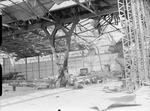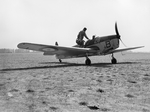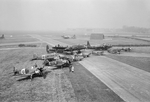M.14 Magister
| Country | United Kingdom |
| Manufacturer | Phillips & Powis Aircraft Limited |
| Primary Role | Other |
| Maiden Flight | 20 March 1937 |
Contributor: Alan Chanter
ww2dbaseFollowing the success of the Miles Hawk trainer on the civilian market and in the elementary flying training school operated by Phillips & Powis (later, in 1943, Miles Aircraft) the British Air Ministry issued specification T.40/36 for a development of the Hawk aircraft as an elementary trainer for the Royal Air Force. With the expansion of the RAF the company was awarded a contract worth £2 million for the new aircraft, designated the Magister which was to make history as the RAF's first low-wing cantilever monoplane with full Air Ministry approval for acrobatic flying, including protracted spins. It also cut across the contemporary Air Ministry policy to use only metal aircraft, by being of wooden construction with plywood covering. It was also the first RAF aeroplane in which magnesium alloy castings were used for stressed parts.
ww2dbaseChanges to the basic design of the Hawk III trainer included larger cockpits and provision for blind flying equipment. The Magister aircraft had two open cockpits in tandem, with dual controls for instructor and pupil pilot. Production began to a revised Air Ministry specification T.37/37 and the first M.14 Magister was christened on 20 Mar 1937, and displayed at Woodley by Managing Director F. G. Miles. Deliveries to the RAF commenced in May 1937, with early production aircraft being virtually identical to the prototype.
ww2dbaseThe aircraft proved reasonably successful with a low landing speed of just 42 miles per hour, but initially pupils found it difficult to recover from practice spins and after a series of crashes, the prototype was flown to the Aircraft and Armament Experimental Establishment at Martlesham Heath, for spinning trials. Unfortunately it would crash during its first flight from the test establishment, the pilot escaping by parachute. Modifications to cure the problem included raising of the position of the tailplane, the redesign of the rear fuselage and decking, and the fitting of anti-spin strakes between the fuselage and the tailplane. When these did not prove entirely satisfactory a new rudder of increased area and higher aspect ratio was fitted and this cured the fault. The modifications were incorporated in all subsequent Magister aircraft, these being designated M.14A. The undercarriage was fixed and although landing gear fairings were fitted as standard on new aircraft these were usually removed in service, presumably to avoid mud clogging the wheels. A later version, the M.14B differed only in the installation of a 135h.p. Blackburn Cirrus Major 2 engine.
ww2dbaseProduction ran from 1937 to 1941, and at its peak reached fifteen completed aircraft per week. The Air Ministry contract covered 1,229 aircraft, but some of these were exported; there were also additional aircraft built specifically for overseas customers. Countries receiving Magister aircraft for military use included Egypt (42), New Zealand (2), Eire (15) and Turkey (4), and this last country also built 100 M.14 Uger aircraft under licence. Before the war a number of M.14 sales to civilian owners were made and, in fact, many RAF Magister aircraft came back on the civilian market as Hawk Trainer III aircraft at the end of the war.
ww2dbaseThe Magister entered full RAF service in Oct 1937 and proved an excellent trainer. At the time of its introduction the first deliveries of Hurricane fighters and Spitfire fighters were being made, and the new trainer, with its low-wing characteristics and split trailing edge flaps, reproduced the handling qualities of these fighters, making the Magister an ideal trainer for fighter pilots. Additionally, several Magisters would be modified to conduct various experimental roles. When a German invasion of Britain was expected, in Jun 1940, racks to carry eight 25-pound bombs were fitted to about fifteen Magister aircraft along with several de Havilland Tiger Moth aircraft similarly converted. In 1941, the Air Ministry asked Miles to experiment with an auxiliary aerofoil surface, or wing, to see if it was feasible that such a device could be used to carry bombs and thereby increase the bomb load of medium bombers. Towed behind a Magister aircraft, the idea was found to be practicable, but the advent of larger bombers would render it unnecessary. Another interesting experiment involved the trials of landing gear legs and wheels which could be castored. This was then considered desirable to simplify cross-wind landings on the new runways which were beginning to appear, replacing the earlier all-grass airstrips on which a landing could be made from any direction.
ww2dbaseIn 1937 the Air Ministry approached Short Brothers to form and manage a flying school to train Royal Air Force Volunteer Reserve pilots at their Rochester airport facility. By Apr 1938, No. 23 Elementary and Reserve Flying Training School was set up at Rochester with Flight Lieutenant R. C. Chambers as the Chief flying instructor assisted by four other experienced pilots. The school was accommodated in a purpose built administration block with its fleet of Avro Tudor, Miles Magister and Hawker Hart aircraft housed in the newly constructed No. 1 hangar. The school would be greatly expanded during 1938 as war clouds loomed, including the training of naval pilots for the Fleet Air Arm. But on Thursday, 15 Aug 1940, eighteen Dornier bombers from the German Luftwaffe's KG3 under the command of Oberst Wolfgang von Charniers Gliusczinsk bombed Rochester, where Shorts were building the Stirling bomber, causing enormous damage which took many months to clear up. As a result Rochester's defences were considerably beefed up and much of the flying training was dispersed to safer areas.
ww2dbaseIn Oct 1939, RAF Manston was designated as a fighter station in No. 11 Group. Wing Commander Hanmer arrived to take command of Nos. 235 and 253 (Hyderabad State) Squadrons who were scheduled to receive Blenheim If aircarft but instead they actually got Miles Magister trainers and Fairey Battle light bombers on which to conduct training during that harsh winter of 1939-1940. The New Year started pretty badly when a Magister from 79 Squadron crashed at Garlinge, near Margate, killing the two crew instantly. The two squadrons eventually moving out in Feb – 235 Squadron, with Blenheim aircraft, going to Coastal Command and 253 Squadron, with Hurricane fighters, moving to RAF Northolt.
ww2dbaseOn Sunday, 23 Nov 1941, two Luftwaffe officers, Leutnant Heinz Schnabel and Oberleutnant Harry Wappler, escaped from their prisoner of war camp near Penrith. With forged identity documents suggesting that they were Dutch airmen serving in the RAF they made their way undetected to RAF Kingstown near Carlisle where, on the next day, they bluffed a young civilian apprentice to let them take a Magister aircraft for taxying tests. Instead the two escapees took off with the intention of flying back to Nazi occupied Europe. Their bid to get home was doomed to failure due to fuel shortage. Forced to turn back they landed in a meadow north of Great Yarmouth hoping to buy petrol, but without money or ration coupons and not knowing that the high-octane petrol used in RAF aircraft was not available to the general public this proved unsuccessful. A local policeman inspected their documents and seemed satisfied. He took them to Caister police station to call for RAF transport to take them to nearby RAF Horsham St Faith where their true identity was soon revealed and the pair were taken back into custody. The failed escapers would subsequently spend 28 days in solitary before being shipped to more secure confinement in Canada.
ww2dbaseThe "Maggie" or Miles Magister trainer would serve with no fewer than sixteen Elementary Flying Training Schools where new pilots received their first ten weeks of flying and ground lessons training, the Central Flying School, and in all RAF commands; the type also saw service with the British Army and Fleet Air Arm. With the army its work included glider pilot training and co-operation with ground forces. Many Magister aircraft were used as squadron hacks, and for general communications duties, and it was recorded that some 40 Fighter Command squadrons each had a Magister on strength. In total 1,293 Magister aircraft together with the 100 Turkish Uger aircraft were built. They lingered on in RAF service until about 1948, when the last were put up for disposal. Today approximately ten of these trainers remain in existence although only a few are still active.
ww2dbaseSources:
David Mondey: British Aircraft of World War II (Chancellor Press, 1994)
Roy Conyers Nesbit: Failed To Return: Mysteries of the Air 1939-1945 (Patrick Stephens Ltd, 1988)
Rod Simpson: Airlife's World Aircraft (Airlife Publishing, 2001)
Robin J. Brooks: Kent Airfields in the Second World War (Countryside Books, 1998)
Chaz Bowyer: Royal Air Force Handbook 1939-1945 (Ian Allan Ltd, 1984)
Wikipedia – RAF Carlisle
Last Major Revision: Mar 2019
M.14 Magister Timeline
| 20 Mar 1937 | M.14 Magister aircarft took its maiden flight. |
SPECIFICATIONS
M.14A
| Machinery | One de Havilland Gipsy Major I 4-cyl air-cooled inline piston engine rated at 130hp |
| Crew | 2 |
| Span | 10.31 m |
| Length | 7.51 m |
| Height | 2.03 m |
| Wing Area | 16.35 m² |
| Weight, Empty | 583 kg |
| Weight, Loaded | 862 kg |
| Speed, Maximum | 212 km/h |
| Speed, Cruising | 198 km/h |
| Rate of Climb | 4.30 m/s |
| Service Ceiling | 5,485 m |
| Range, Normal | 612 km |
Photographs
 |  |  |  |
Did you enjoy this article or find this article helpful? If so, please consider supporting us on Patreon. Even $1 per month will go a long way! Thank you. Share this article with your friends: Stay updated with WW2DB: |
- » Wreck of USS Edsall Found (14 Nov 2024)
- » Autumn 2024 Fundraiser (7 Nov 2024)
- » Nobel Peace Prize for the Atomic Bomb Survivors Organization (11 Oct 2024)
- » Wreck of USS Stewart/DD-224 Found (2 Oct 2024)
- » See all news
- » 1,150 biographies
- » 337 events
- » 43,917 timeline entries
- » 1,241 ships
- » 350 aircraft models
- » 207 vehicle models
- » 374 weapon models
- » 123 historical documents
- » 260 facilities
- » 470 book reviews
- » 28,541 photos
- » 432 maps
Joachim von Ribbentrop, German Foreign Minister, Aug 1939
Please consider supporting us on Patreon. Even $1 a month will go a long way. Thank you!
Or, please support us by purchasing some WW2DB merchandise at TeeSpring, Thank you!